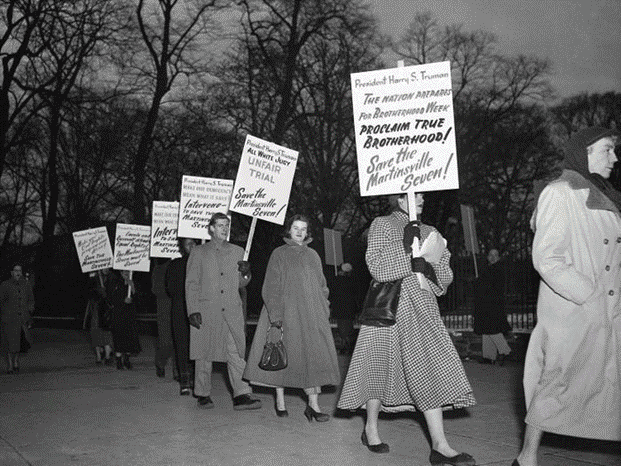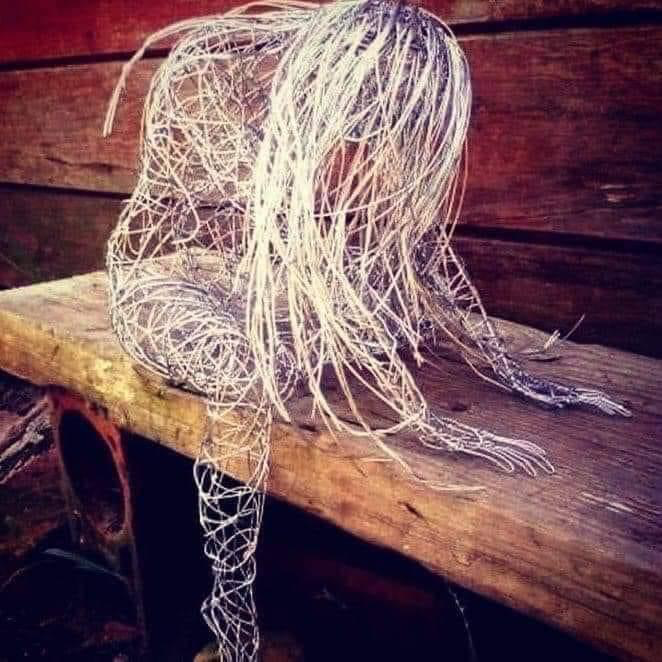Mandingo -From Nat Turner to George Floyd
"Southern trees bear a strange fruit, blood on the
leaves and blood at the root. Black bodies swinging in the Southern breeze,
strange fruit hanging from the poplar trees."
— "Strange Fruit," written by Abel Meeropol and recorded
in 1939 by Billie Holiday
"To be a Negro in this country and to be relatively conscious
is to be in a rage almost all the time." -James Baldwin.
Slave merchants and owners created the sexualized,
strong, brutish, animalistic Black man known as Mandingo. Mandingo, though
paraded as being a physically powerful Black man, had to be continually and
often brutally subdued and forced into labor. He was the chief protagonist in
the 'Birth of a Nation" (1915) after emancipation which raped the innocent
daughters of Whites throughout the South. This trope led to the thousands of
lynchings of Black men as White men sought revenge for these presumed wrongs.
The Mandingo trope, highly influenced by the story of
Nat Turner, projects the Black male as angry, hostile, and rebellious. The story
of Nat Turner, an enslaved person who learned to read and write and became a
preacher. After a vision from God, he planned and executed one of the most
effective, sustained slave rebellions in U.S. history on August 21, 1831. In this
rebellion, 60 whites were killed, but over 200 Blacks were massacred as Whites sought
revenge. The Turner rebellion was the worst nightmare for the White Slavocracy
as "visions of angry Black men hell-bent on exacting revenge" disturbed
the gentile vision of the "happy slave." (James
2010). In response, Black people across the South were forced to endure
even more "cruel, barbaric, and traumatizing forms of control." Nine states -Virginia, Alabama, Delaware,
Georgia, Louisiana, Maryland, North Carolina, South Carolina, and Tennessee
-passed various laws limiting black people's mobility. These laws banned
the free assembly of Blacks, independent religious services, or preaching to a
crowd of more than five. Educating Blacks or Blacks to learn to read or write
became illegal. (Coleman
2021) The Turner rebellion also fostered
similar slave insurrections in places like Maryland. But instead of enslaved
people, free Black residents planned and orchestrated slave insurrections. Panicked slaveholders in the state pushed the for-state legislation that
enacted repressive laws targeting free and enslaved Black residents. One very aggressive
plan, produced by the publicly funded Maryland Colonization Society, sought to force
even free Black Marylanders back to West Africa, create separate Black public schools,
and exclude and discriminate against hiring Black skilled workers. All of these
were upheld as Maryland native and Chief Justice Roger B. Taney and six other Supreme
Court justices ruled in the 1854 Dred Scott decision that "enslaved African
race," and free people of color had no claim to either freedom or
citizenship under the U. S. Constitution. The backlash extended to so-called
free states such as Ohio and Indiana, even barring free Blacks from settling in
the state. (Baltimore
Heritage n.d.)
The angry Black man has historically been a top media
personage, as witnessed by such was Jack Johnson, a.k.a. The Great Black Hope. And while there is a parkway for Jackie Robinson, Paul Robeson has a postage
stamp. Many have forgotten Johnson, who was condemned for his "Unforgivable
Blackness" (2004). Johnson
earned the label as the first Black World Heavyweight champion in 1908,
defeating James Jeffries, who had been tagged the "Great White Hope."
Many whites looked on in horror as their "Hope" was lost and began
attacking black people throughout America. Dozens of race riots erupted across
the United States as Whites vented their frustration and fear of this "angry
Black Man." Lynchings also spiked as 67 black men were killed for no
reason then, and whites were angered that Black Americans dared to celebrate
Johnson's victory. Even the films of Johnson's victory caused so much rioting
that Congress in 1912 banned the interstate transportation of boxing films. This
law was in effect until 1940. (Gustkey
1990)
These events legitimized the angry Black man stereotype
and the fear, anxiety, and retribution within White racial frames. Rebecca
Latimer Felton, a writer and politician summed up for many the White attitude
toward Black males and lynching. "If it needs lynching to protect woman's
dearest possession from the ravening human beasts, then I say lynch a thousand
times a week if necessary." On average, six people were lynched every
month between 1880 and 1950.
The largest mass execution for rape ever reported in
the United States occurred in 1951, as seven black men were accused, convicted,
and executed for the rape of a white woman. Seventy years later, the governor
of Virginia pardoned all seven. Justice delayed is still justice denied. White
mobs frequently lynched black men under the presumption of sexual
transgressions against White women. Though routinely, these accusations were
fabricated, they reflected the fears of Whites. These fears had little to do
with the presumed violence and hypersexuality of the Black men but with the
need to enforce the segregation of the races. The murder of 14-year-old Emmett
Till in 1955 was one of the last lynchings. Till's offense was allegedly
flirting with a White woman. It was not until 2017, sixty years later, that the
accuser, Carolyn Bryant Donham, recanted her accusation that Till had" grabbed
her by the hand and waist and acted lewdly." The two White men, Bryant and
Milam, were acquitted of Till's kidnapping and murder by an all-male, all-white
jury in September of 1955. (Kimble
2017)
Source: Emmett Till's Accuser Carolyn Bryant Says Part of Her Story
Is False (people.com)
Black men, uncontrolled, were a threat to public
safety and the decency of White women. "Black brutes" became reviled,
paraded, and promoted, as seen from Hollywood to Sports. Mandingo first appears
in the classic 1933 film King Kong, then again in 1976. In each of these, a
25-foot-tall gorilla goes to his death in pursuit of a white woman. This same trope
reappears in the "Lord of the Rings." All of these promoted and
played on the notions of "Black male hypersexuality" targeting
innocent White females. (Bates 2005)
In the real world, when leaders such as Malcolm argued that Blacks must use "any means necessary" to obtain their rights, whites cringed with fear and looked at him as a dangerous Black man. They suddenly loved the peaceful and confronting presence of Rev. Martin Luther King, Jr. was viewed as less threatening. (James 2010)
In 2008 the Vogue magazine cover depicted N.B.A. legend
Lebron James and a blonde in a pose eerily reminiscent of one representing King
Kong and a blond woman. These portrayals continued the trope of Black men as
brutes and monkeys who must have a White woman. This cover would appear during
the same year that a Black man, Barrack Obama, was running for president. (Morris
2008)
Many Black men, intentionally or unintentionally, have
embraced the Mandingo troupe as the hyper-sexualized or angry Black male. Public
figures such as Bill
Cosby or R.
Kelley have a long history of rape and sexual imposition, and the decades where
they appeared to be above the law. Their behavior and the lack of immediate prosecution
demonstrate the power of such behavior and how we have normalized it. This normalization
applauds and rewards Black hypersexuality. Consider the long list of Black male
hip-hop stars recently making the news, including Mystikal,
Ll Mosey, Cash
Out, etc. A long list of Black professional athletes includes N.F.L. players
Darren Sharper and Thomas Henderson, or N.B.A. players such as Tom Payne or former
heavyweight boxing champion Mike Tyson.
Similarly, the angry black male has been normalized in different ways. On the one hand, this recognizes that we all get mad
sometimes. And on the other hand, it reflects the righteous indignation advocated
by Malcolm X. Still, one condition can be termed "toxic masculinity"
that reflects a more troubling internalization of a negative stereotype. Several examples are readily available. For example, consider the story of Ja
Morant, who plays for the Memphis Grizzles. Jo Morant, one of the brightest
stars in the N.B.A., has a Nike shoe brand, a top-selling jersey, and is on a
winning team. But he also has a list of violent episodes where he is accused of
shoving, beating, and threatening behavior. But, while these incidents have
been reported to the police, there have yet to be any charges. (Hensley-Clancy,
2023)
The internalization of these stereotypes has obvious outcomes,
as we have seen. Still, the less obvious reactions to these stereotypes by
police and educators, judges, politicians, and everyday citizens have led to repeated
tragedies. George Floyd and Michael Brown joined over 200 mostly Black men killed
by police since 2020. (Raham
2021) Unarmed Black people, in
general, and Black men are more than three times more likely to be fatally shot
by police. (Lett, Asabor,
Corbin, and Boatright, 2020) Half of the 250 kids expelled daily from
preschool are Black boys. (Novak
2023) Black boys lost an average of 132, and Black girls lost 77 days per
100 students enrolled, compared to just 21 days for their white peers due to out-of-school
suspensions. (Camera
2020) Not only are black Men more likely to be criminalized, but they are also
more likely to serve 19.1 percent longer than their white counterparts for
similar crimes. (King
2017)






Comments
Post a Comment